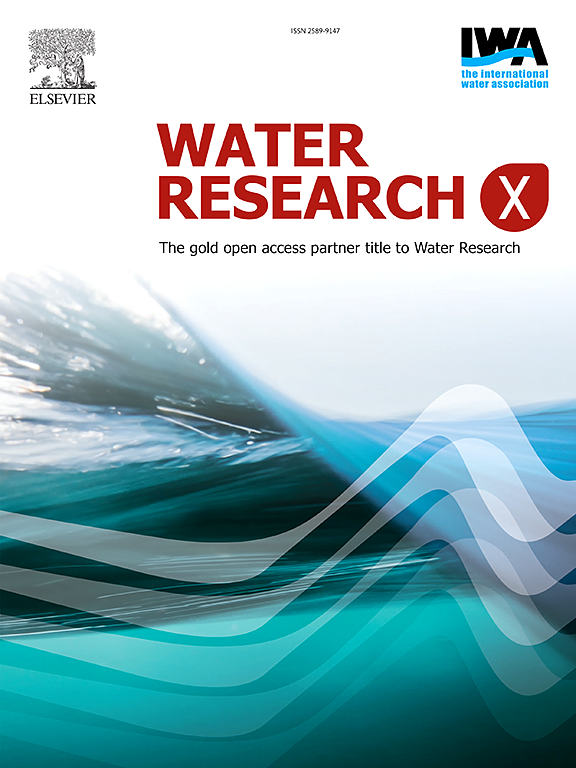非均相Fenton辅助去除废水中的抗生素:四种Fenton工艺中FeWO4纳米材料形态的影响
IF 8.2
2区 环境科学与生态学
Q1 ENGINEERING, ENVIRONMENTAL
引用次数: 0
摘要
水中抗生素的发病率日益增加,对环境和健康构成了相当大的挑战,包括抗生素耐药性和遗传毒性。本研究的重点是通过简单的水热法合成三种不同形态的FeWO4纳米材料——纳米颗粒(NPs)、纳米棒(NRs)和纳米纤维(NFs)。在常规Fenton (CF)、光Fenton (PF)、sono-Fenton (SF)和sono- photofenton (SPF)四种Fenton高级氧化工艺(AOPs)中,对这些纳米材料作为非均相催化剂进行了评价。系统地评价了FeWO4纳米材料的各种形态结构对废水中常见的抗生素污染物环丙沙星(CIP)的降解性能。采用UV-Vis DRS、FESEM、XRD、EIS和CV对合成的纳米材料进行了表征。理化分析证实了合成的FeWO4纳米材料在光学和催化性能上的差异。在四种Fenton工艺中,光-Fenton和声纳-光-Fenton工艺比常规Fenton和声纳-Fenton工艺具有更高的CIP降解效率。然而,SPF工艺在中性ph下,使用低剂量的FeWO₄NPs (100 mg/L)和H₂O₂(2.0 mM),在40分钟的处理时间内,可以高效地从水溶液中去除近99%的环丙沙星(CIP)。与其他两种形态相比,FeWO4的纳米颗粒形态表现出优异的性能。这一突破性的发现强调了FeWO4作为多用途和高效的纳米材料在fenton基AOP工艺中用于减轻水生环境中抗生素的巨大潜力。本文章由计算机程序翻译,如有差异,请以英文原文为准。
Heterogeneous Fenton-assisted antibiotic removal from wastewater: Effect of FeWO4 nanomaterial morphology across four Fenton processes
The growing incidence of antibiotics in water presents considerable environmental and health challenges, including antibiotic resistance and genotoxicity. This research focuses on synthesizing FeWO4 nanomaterials in three distinct morphologies- nanoparticles (NPs), nanorods (NRs), and nanofibers (NFs) via a facile hydrothermal process. These nanomaterials were evaluated as heterogeneous catalysts in four different Fenton-based advanced oxidation processes (AOPs): conventional Fenton (CF), photo-Fenton (PF), sono-Fenton (SF), and sono-photo-Fenton (SPF). The performance of each morphological structure of FeWO4 nanomaterials was systematically assessed for the degradation of ciprofloxacin (CIP), a common antibiotic pollutant found in wastewater. The synthesized nanomaterials were characterized using UV–Vis DRS, FESEM, XRD, EIS, and CV. The physicochemical analysis confirmed the differences in optical and catalytic properties of synthesized FeWO4 nanomaterials. Among the four Fenton processes, photo-Fenton and sono-photo-Fenton processes demonstrated higher CIP degradation efficiency compared to conventional Fenton and sono-Fenton processes. However, the SPF process demonstrated high efficiency in removing nearly 99% of ciprofloxacin (CIP) from aqueous solution, using a low dose of FeWO₄ NPs (100 mg/L) and H₂O₂ (2.0 mM) over a 40-minute treatment period at neutral pH. The nanoparticle form of FeWO4 exhibited outstanding performance compared to the other two morphologies. The groundbreaking discovery emphasizes the immense potential of FeWO4 as versatile and efficient nanomaterials in Fenton-based AOP processes for mitigating antibiotics in aquatic environments.
求助全文
通过发布文献求助,成功后即可免费获取论文全文。
去求助
来源期刊

Water Research X
Environmental Science-Water Science and Technology
CiteScore
12.30
自引率
1.30%
发文量
19
期刊介绍:
Water Research X is a sister journal of Water Research, which follows a Gold Open Access model. It focuses on publishing concise, letter-style research papers, visionary perspectives and editorials, as well as mini-reviews on emerging topics. The Journal invites contributions from researchers worldwide on various aspects of the science and technology related to the human impact on the water cycle, water quality, and its global management.
 求助内容:
求助内容: 应助结果提醒方式:
应助结果提醒方式:


